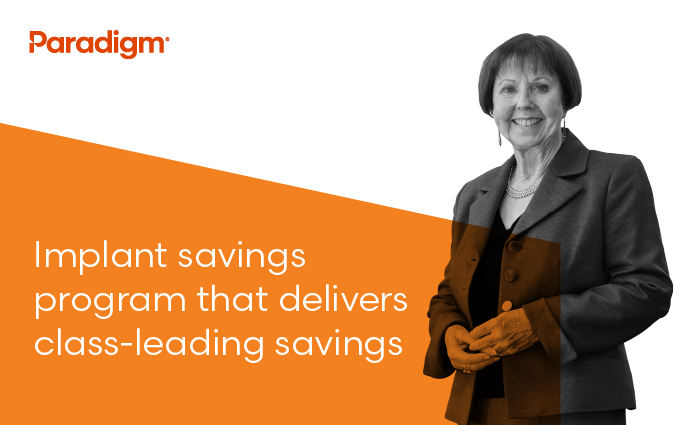01/04/2024

As surgical implant technology grows more complex, managing surgical implant spend becomes increasingly difficult. A surgical implant review centered on intelligent, data-driven expertise can bring pricing objectivity, transparency, and significant savings to healthcare payers.
Clinical reviews, conducted as part of a medical bill review process, are common in the healthcare industry—medical bills may be reviewed for many different reasons by high-level coders, nurses, and other medical professionals. But in many situations, these reviews are not able to maximize surgical implant savings. This is because these clinical reviewers often don’t have the necessary resources and/or the specific expertise needed to identify major cost drivers.
To be effective, an in-depth surgical implant review must be able to accurately:
An industry standard clinical review could potentially address some of these items, but savings are often lost without implant-specific, data-driven analysis. An in-depth surgical implant review should address reductions objectively and in a defensible manner to minimize provider disputes. Here is why each of the above categories is critical to the bill review process.
Interpreting contract provisions
Surgical implant bill review procedures need to be able to account for and interpret the high degree of variance among payer and provider contracts. Although no two contracts are exactly the same, there are four primary types of reimbursement models for surgical implants in healthcare cases. An effective surgical implant review should be able to identify and respond to each of the following regulation categories:
Matching invoices to the procedure
It is imperative to match the implants billed to the procedure. In many cases, when a facility submits invoices, they include items the facility purchased from the manufacturer for other surgical procedures and not just items used for the billed procedure. An in-depth review requires the knowledge and expertise to match the items on the invoices to the specific items used in the procedure—including the quantity of each item. Additionally, a facility often bills and includes invoices for implant items that were not left in the body. Most contracts and policies clearly state an implant must be left in the body for it to be reimbursed. It is common for an implant to be classified as an “in-and-out.” This means the implant was placed in the body, but before the procedure was completed, the implant was taken out. An example of an in-and-out would be when the surgeon does not feel comfortable with the size or fit of the implant. In this situation, the surgeon would remove the implant. A nurse or medical professional may conduct a clinical review, but there is a much higher chance of miscalculation without specific implant manufacturer expertise. For example, it can be notoriously difficult to know exactly how many screws were used or needed for a specific device.
Identifying billing errors
Many facilities erroneously bill for items not classified as implants or send invoices for implant items not reimbursable under payer policies and contracts. For example, facilities may bill in error for supply items under the revenue code for implants when the supply items should have been billed using the revenue code for sterile supply. Again, an in-depth surgical implant review requires the expertise to identify these types of situations to maximize carrier and payer savings.
Assessing a facility’s true acquisition cost
Establishing the true acquisition cost of implants is arguably the most difficult, but most important, category of an accurate surgical implant review. The three previous categories of review primarily address how the facility uses implants. This category specifically addresses the cost. The two most common methods for measuring a facility’s acquisition cost are requesting invoices from the facility or leveraging an external source to obtain an
estimated acquisition cost. Requesting invoices from the facility may result in a retail invoice and not the facility’s actual acquisition cost.
The most common external source for obtaining acquisition cost data is a group purchasing organization (GPO) database. Typically, the GPO acquisition cost data is based on average cost within a handful of geographical regions and includes data from all lines of business, such as workers’ comp, auto insurance, and group health. Therefore, this GPO cost data can be limited and segmented because the GPO data does not contain detail at the facility level.
The value of an optimal implant review solution
Although surgical implants are a small portion of total healthcare claim volume, the total medical spend on implants can be extremely high. In fact, it can account for more than 20% of a surgical bill for many payers. One surgical implant review could lead to thousands and potentially tens of thousands of dollars in savings. It is not unusual to see a facility bill eight to 10 times the true acquisition cost.
Any payer should be asking questions about their current medical bill review process. Does the current program have a clinical review and if so, do the clinical reviewers have the surgical implant expertise to maximize savings? Does the clinical reviewer have a database capable of calculating true acquisition costs at the facility level, or do reviewers calculate reimbursement based solely on invoices supplied by the provider?
Implementing a surgical implant review is far less costly and resource-intensive than many organizations think. Most payers use claim repricing software easily configured for clinical-level reviews, so adding a surgical implant review can often be a low-impact addition that does not place a burden on the current claim repricing workflow. Substantial savings with minimal implementation effort makes a surgical implant review process a “must have.”
Paradigm’s Implant Savings Program delivers class-leading savings across every implant-related category. In fact, this solution reduces surgical implant costs by 25 percentage points more than other industry offerings, according to independent research. Using intelligent, data-driven systems and a dedicated, implant-specific adjudication process, Paradigm rigorously evaluates each case according to client provider contracts, clinical and payment policies, and applicable regulations to give payers peace of mind that they are paying the true acquisition cost, not retail cost, for every implant on every claim.